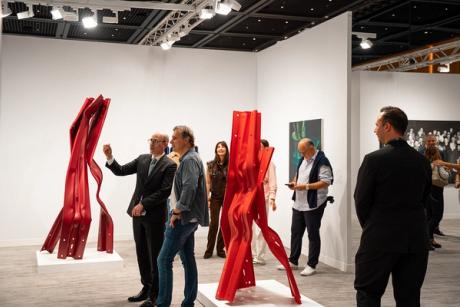
Collection agencies from throughout Europe, the United States and Turkey merged at the extravagant Tersane Istanbul complex– a restored Footrest shipyard forgeting the Golden Horn– for the opening of Contemporary Istanbul (CI, up until 28 September) on Tuesday. Commemorating its 20 th anniversary, the reasonable brought together 51 galleries from 16 countries.
This year’s edition accompanied the Istanbul Biennial, which drew a bigger crowd of enthusiasts and gallery groups contrasted to the previous year. The fair showed stronger quality than its early versions, with works by leading Turkish musicians such as Nil Yalter, Güneş Terkol and Azade Köker shown.
Numerous cubicles showed fabric and ceramic-based pieces alongside paints, with rates spanning EUR 1, 000 for young arising musicians to above EUR 2 m for a significant James Rosenquist painting, previously showed at the Guggenheim Museums in New York and brought by the local gallery Sevil Dolmaci.
Spirits were high at the reasonable but Turkey’s socio-political climate continues to be sensitive. Considering that the arrest of Istanbul mayor Ekrem İmamoğlu previously this year, demonstrations have actually proceeded partially of the nation.
Yet Ali Güreli, the chairperson and owner of Contemporary Istanbul, and creator of The Art Newspaper Turkey continues to be optimistic regarding the country’s art scene. “We must be tranquil,” he states, adding that it’s likewise important to be “extreme and clever.”
“Censorship is nothing new”
Despite an environment of raising censorship and pressure on cultural institutions, the city’s art ecosystem continues to be resilient. Neighborhood musicians remain to find innovative methods to create essential, socially engaged job, a few of which Turkish galleries presented at the fair.
Pilevneli gallery showed a hyper-realistic paint, You are Safe Right here (2025, by the Turkish artist Rasim Aksan, valued at about EUR 120, 000, visible from the home window of their short-lived street-level space. The significant triptych depicts seafarers boozing in what appears to be a gay bar, with homoerotic paintings behind-the-scenes. It was a bold option considered that LGBTQ+ themes run the risk of censorship in Turkey.
The Istanbul- and Berlin-based Zilberman gallery showed Nazar/Eye (2019, a textile job by the Kurdish feminist musician Fatoş İrwen, developed throughout her imprisonment , naturally stitched with human hair and pierced with safety pins. At the same time, Pilot gallery displayed the Turkish musician Halil Altındere’s bronze Pinocchio sculpture, whose lengthy nose becomes a mop.
“It’s talking about just how it’s rarely feasible to sweep up your very own lies with even more lies, but the piece is not guided in the direction of any particular celebration or politician,” claims Marcus Graf, a teacher at Yeditepe University, keeping in mind that the artist’s refined strategy is common. “That’s the Turkish means … Censorship is nothing brand-new. Because the 1980 s, after the army stroke of genius, the constraint of freedom of expression has actually been entirely different from the West.”
He adds there is increased care regarding religious beliefs currently: “You won’t see anyone– a minimum of not honestly– criticising religious programs.”
Gathering amid rising cost of living
While the sneak peek left to a sluggish start, several Turkish galleries rehung their booth on the second day. Local gallery Dirimart offered a Tony Cragg sculpture, and Sevil Dolmacı gallery offered a Turkish artist Nilbar Güreş work for EUR 35, 000 Pilot Gallery marketed an Altındere paint to a French collector for EUR 50, 000 Zilberman offered a number of mixed-media works by Turkish musician Azade Köker, valued from EUR 9, 500 to EUR 45, 000 They additionally marketed a job by Slovakian musician Lucia Tallova for EUR 8, 000
Zilberman’s program supervisor Ece Ateş kept in mind, nevertheless, that lots of collectors were asking for price cuts due to the current economic climate. Turkey’s GDP grew 4 8 % over the previous year, surpassing expectations, though rising cost of living continues to be above 30 %.
“Turkey is always inverted– it resembles a roller rollercoaster. Twenty years earlier, it was the same,” claims the owner of Pilot Galerie Azra Tüzünoğlu, referring to past recessions. “However the whole world has problems now. The mood isn’t excellent anywhere.”
A number of international galleries reported sales on the reduced end. Some noted that enthusiasts lacked the necessity or decisiveness of buyers in bigger fairs. Heft Gallery– among 11 newbies to the reasonable– offered 2 works by Edward Burtynsky made in cooperation with the generative AI artist Alkan Avcıoğlu for EUR 13, 700 each and 2 jobs by Nancy Burson for EUR 12, 800 and EUR 10, 300 One more first-time exhibitor, New York-based Amanita Gallery, offered jobs by Nicholas Campbell and Adrian Schachter in the series of concerning EUR 8, 600 to EUR 12, 800
Lots of abroad exhibitors were pleased with the result of the fair. Barbara Čeferin, the owner and proprietor of the Slovenian gallery Galerija Fotografija, who was additionally attending for the first time, stated she had her eye on this fair for years and had not been let down: “Istanbul has financial power and individuals that treasure art.”
Next year, CI’s Güreli plans to target Eastern exhibitors and broaden the fair to 70 galleries. Contemporary art galleries are additionally anticipated to open quickly in Tersane Istanbul, highlighting the vigor of the wider art scene. “Turkish society is extremely crisis-experienced,” Graf claims. “That’s what I admire about the [local art institutions]– regardless of all the tumult, they always continue.”